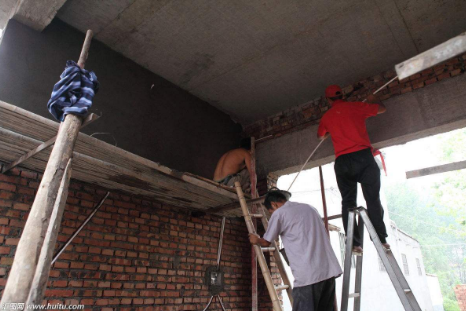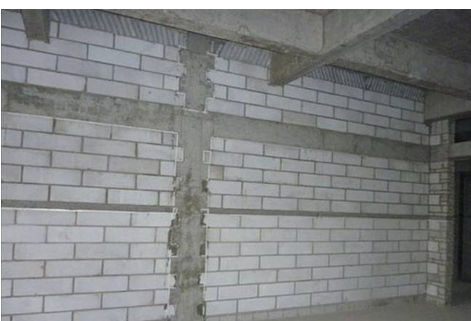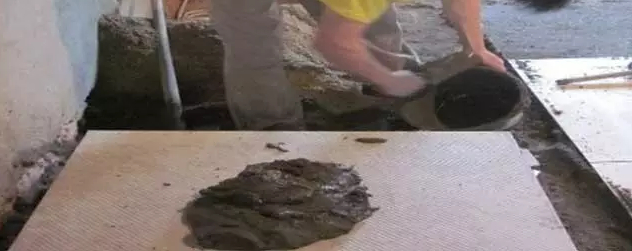Although the proportion of volume occupied by masonry mortar in aerated concrete block masonry is much smaller than other block masonry, improper use of masonry mortar and trowel mortar cause cracking of aerated concrete block masonry wall. The probability is much higher than masonry of other materials. In JGJ/T 17-2008 of Chinese standard, it is very important to use special mortar for masonry and plastering. However, the engineering and technical personnel of some design and construction companies often overlook the importance of a reasonable choice of mortar; a considerable number of construction supervisors are not very clear, the mortar may cause harm to the wall of aerated concrete block.

The cause of cracking of aerated concrete block walls caused by improper use of mortar is very complex, and is often the result of a combination of factors.
(1) The internal stress caused by the shrinkage of the mortar itself will crack the block or mortar joint. In the hardening process or water loss process of cement mortar, the production of shrinkage deformation stress is one of the most common factors that produce cracks, including chemical shrinkage, drying shrinkage, autogenous shrinkage, temperature shrinkage, and plastic shrinkage.
(2) Cracks caused by improper selection of masonry and plastering mortars. The compressive strength of aerated concrete cube specimens is between 3.5MPa and 5.0MPa. When the strength of the masonry and plastering mortar used is too high, the elastic modulus between the two is too different and it is easy to pull due to inconsistent deformation. Stress causes cracking.
(3) Poor water retention of the mortar causes cracking of the wall later. Aerated concrete can easily absorb the moisture contained in the fresh mortar, resulting in the mortar “lost” and the strength is not up to the standard, resulting in the cracking of the wall building mortar joints, or cracking of the plastering mortar layer.
(4) If the difference between the thermal conductivity of the plastering mortar and the aerated concrete block is too large, it may cause cracking.
(5) When the linear shrinkage of the plastering mortar and the aerated concrete block is too large, the internal stress caused by the inconsistent deformation can also cause cracking. In addition, if the plaster is plastered on the same surface of the wall with materials of different strengths and shrinkage values, it is easy to crack at the interface between two different materials after plastering.

How to start from the mortar to avoid cracks
1. Measures for strong water absorption of aerated concrete. Aerated concrete blocks have high water absorption but slow water absorption. According to experience, when the moisture content of aerated concrete block surface is controlled at 10%~15%, the wall is more suitable. It is recommended that the surface should be wetted under different climatic conditions to prevent the dry block from being directly on the wall and to prevent the mortar from being wetted. Blocks dry and reduce the strength of the mortar. Another measure is to improve the water retention of the mortar. The common practice is to improve the water retention of the mortar by adding admixtures.

2. Special grouts are used for masonry and plastering; blocks of different dry density and strength grades cannot be mixed, nor can they be mixed with other bricks or masonry blocks.
3, when buried on the wall of wire and pipe, should be in the masonry mortar to reach the design strength (usually after a week) with electric cutting machine tick, wire tube buried after the use of special masonry mortar repair fill. This procedure should be completed before plastering.
4. Plastering can only begin after the wall has been masoned for at least 14 days. Firstly, layered repair is performed on the surface of the surface of the masonry aerated concrete block, and the surface of the substrate is wetted by watering. It is necessary to prevent the plaster mortar from sucking away a lot of water before it is fully hydrated.
5. The minimum strength grade of masonry mortar should not be lower than M2.5, and the consistency of mortar should be 70mm~100mm.
6. The mix ratio of plastering mortar should be determined according to the nature of the block. Plaster mortar strength and wall surface strength as close as possible, in order to ensure the two similar linear expansion coefficient. At the same time, the proportion of coarse sand and medium sand in the mortar should be properly increased to reduce the water absorption and dry shrinkage of the mortar, and mortar admixtures should be used to improve the fluidity and workability of the mortar.
DJY Machinery offers you the more professional design and service of construction industry !!!

Cell Phone: +86 15137175832
Whatsapp: +86 15137175832
Email: sunnydjy823@gmail.com
efficientservice@outlook.com
Address: Dejinyang company